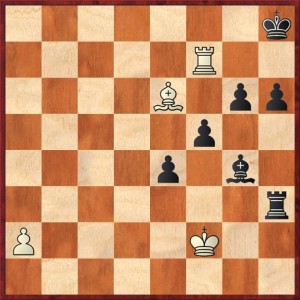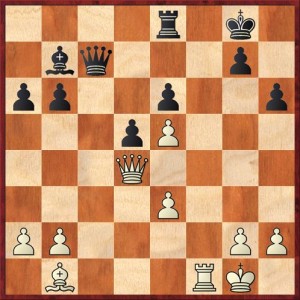The U.S. Amateur Team Championship playoffs were held today at the Internet Chess Club. As you might remember, I played on the team that won the West division back in February. This was our chance to see how we compared against the rest of the country.
I’m sorry to say that we did not win the national championship. We made it to the final match against the East team (Atulya Shetty, Kevin Mo, Michael Bowersock, and Hibiki Sakai), but they defeated us convincingly, by a 3-1 score. Congratulations to the champions!
Nevertheless, as Robin Cunningham (our team captain) said, we finished second out of more than 400 teams. I didn’t see anyone on our team who seemed depressed by the result, mostly because it was so much fun playing in this competition and none of us had really expected to do this well.
So here’s what transpired today.
In the semifinals, we were paired against the North team and pulled off yet another of our miraculous 2½-1½ victories. (For those readers who can’t remember back to February, we won our last four matches in the tournament by that identical margin. In each of the last three matches our score included a draw or a win from a position that had been lost at some point.)
Today’s miracle-worker was Steven Gaffagan on fourth board. The score was tied, 1-1. Steven and Julian Chan, on second board, were playing very different endgames. Julian had a queen endgame where he was at various points a pawn or two pawns up. The only question was whether he would have time to pull out a victory, because he was down to less than 30 seconds and therefore living on the 5-second-per-move increment.
Meanwhile, Steven was in the following seemingly hopeless position.
7k/5R2/4B1pp/5p2/4p1b1/7r/P4K2/8 b – – 0 1
Steven, playing White, is three pawns down. But he set up a little trap with his last move. You’d think that Black would see it, but he was probably in autopilot mode, thinking that “Anything wins.”
So Black played 58. … e3+ 59. Kg2 e2?? The simple 59. … h5, creating a flight square for his king, would have won effortlessly. But now Steven’s dreams came true; after 60. Rf8+ Kg7 61. Rf7+ Kg8 62. Rf6+! (probably the move his opponent overlooked in time trouble) there is no way for Black to escape the checks.
What a save! A draw in a game where we were three pawns down! Caissa was smiling on us.
After that miracle, Robin told Julian, “Just don’t lose!” But Julian did better than that. His opponent eventually allowed a queen trade and that left Julian with an elementary win in the king and pawn endgame.
Whew! All of that drama within about five minutes!
Meanwhile, the East team drew their match against the South but won the 15-minute playoff, so we were matched against them in the finals.
The match started off well for us. By prior agreement I replaced Steven on fourth board. I outplayed Hibiki Sakai to give us a 1-0 lead. Unfortunately, Julian’s position was looking really sick by this time, and he eventually lost to make the score 1-1.
For a while our positions looked okay on the other two boards, but they gradually turned against us. Robin played a pawn sac and didn’t get quite enough play for it. Todd could have sat on his position forever, but it finally opened up and his opponent had many more threats than he did. It was a downward spiral, where the worse things got on one of my teammates’ boards, the harder the other teammate had to try to win. But that made things worse on their board, and so on. Eventually we ended up losing both games.
I really think the teams were closer than the final score indicated, but still there is no question that the East team deserved to win. They outplayed us on three boards.
At least my game was pretty satisfying. Here is how it finished.
4r1k1/1bq3p1/pp2p2p/3pP3/3Q4/4P3/PP4PP/1B3RK1 b – – 0 1
Let me first say that Black’s next move is not a blunder, because he is already busted. However, he probably didn’t realize how much trouble he was in. He played 28. … Rf8 with very little thought. Do you see how White wins after this?
The answer is 29. Bh7+!, a deflection sacrifice. He played 29. … Kxh7 30. Rxf8 and then resigned. Not only has Black lost the exchange, he is totally without counterplay.
As I said, even with best play in the diagrammed position Black loses. He has to play 28. … g5 in order to defend h7, but this fatally weakens the kingside pawns. White now plays 29. Qd3, with the nasty threat of 30. Qg6+ picking up the rook. If Black tries to prevent the incursion with 29. … Qg7, now 30. Rf6! is lights out. If 30. … Kh8 31. Qf1! threatens Rf7, and there is just no stopping it. A very elegant maneuver!
After 28. … g6 29. Qd3 the alternatives are no better. If 29. … Re7 30. Qg6+ followed by mate next move. Or if 29. … Rc8 30. Qg6+ and White picks up either the h-pawn or e-pawn with check. Finally, if 29. … Rf8 30. Qg6+ Qg7 31. Qxe6+ Kh8 32. Rf6 is again just brutal.
The whole game, if you’d like to see it, is below.





{ 2 comments… read them below or add one }
In the diagram from your game, can Black defend with 28 … Re7 29. Qd3 Rf7?
Hi Mike,
That’s a nice idea that I didn’t see in the game. However, White retains a terrific bind after 28. … Re7 29. Bg6, when Black can never challenge the f-file. A little non-computer analysis suggests that after 29. … Qc5 (the feistiest move) 30. Qf4 Qc8 31. h3 Rc7 32. Kh2 Black cannot succeed in trading rooks because of back-rank mate threats. White can just bide his time, and over the long run I don’t think that there’s anything Black can do to stop an eventual penetration to f7 or f8. (Note that if White can reposition his queen behind the rook, then Rf8+ followed by Bh7+, winning the queen for a rook and bishop, becomes a possibility.)